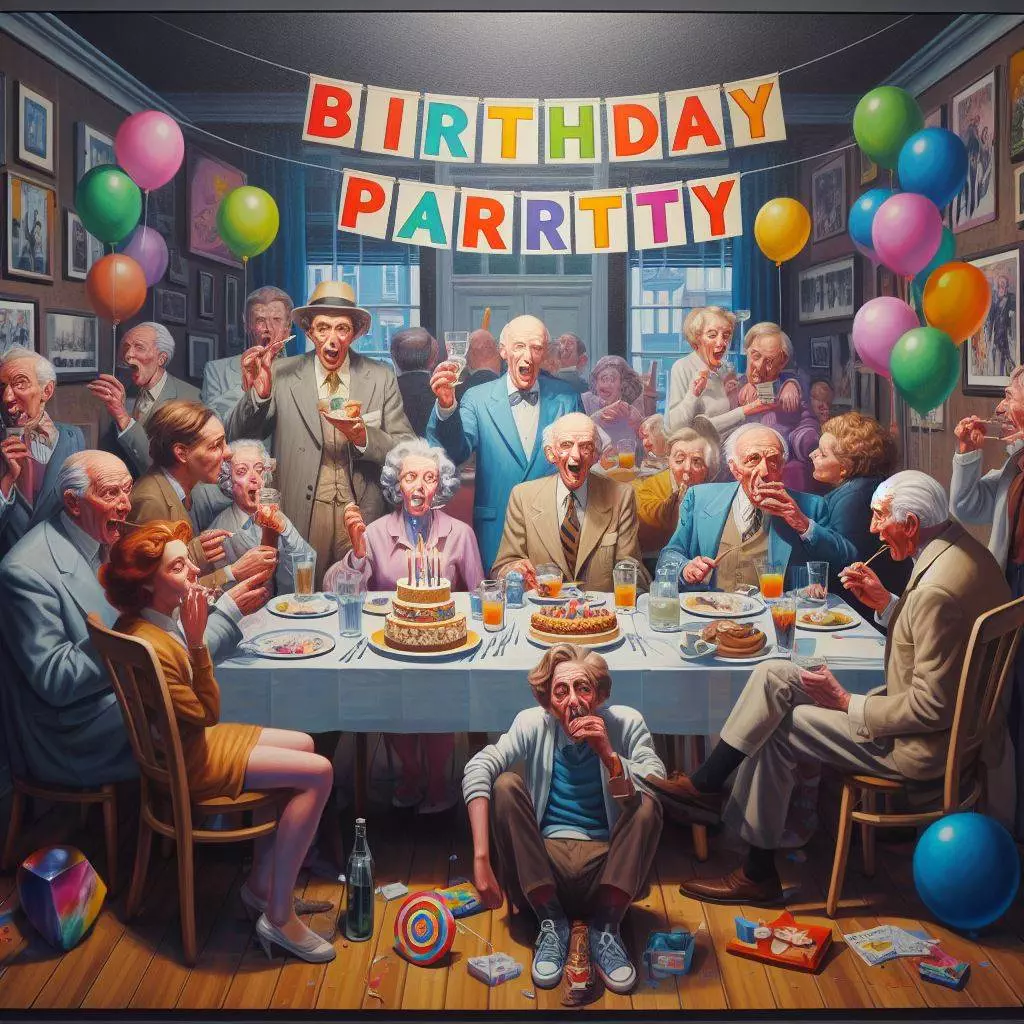Harold Pinter’s 1957 play The Birthday Party fused comedy and menace to create a now-classic work of absurdist theater. Through poetic dialogue and everyday characters, Pinter slowly builds an atmosphere of absurdist menace and ambiguity.
Table of Contents
In this post, we’ll analyze key elements of the play and how Pinter created a strange world hovering between the ordinary and surreal. Whether you’re a theater fan or simply enjoy powerful storytelling, keep reading for an immersive look at this pioneering play.
Overview of The Birthday Party
The play unfolds at a rundown seaside boarding house run by Meg and Petey Boles. Their only tenant is Stanley Webber, a washed-up piano player who spends his days in solitude.
On the morning of Stanley’s birthday, two mysterious strangers named Goldberg and McCann arrive and decide to stay. They throw an impromptu birthday party for Stanley, but their intentions seem unclear.
As the play proceeds, Goldberg and McCann become increasingly aggressive and accusatory toward Stanley, all while speaking in poetic non-sequiturs.
The climax arrives when they attack Stanley, destroying his glasses and dragging him out of the house against his will as Meg and Petey watch helplessly.
Pinter provides little explanation or resolution, leaving the motives ambiguous. But the increasingly surreal, menacing tone imprints a powerful absurdist impression.
Using Everyday Absurdity
Pinter crafted an unsettling world by subtly distorting the familiar. On the surface, the characters and their conversations seem mundane:
- Meg cooks breakfast and tidies up
- Petey reads the paper and makes small talk
- Stanley struggles to remember his past
- Goldberg and McCann ask banal questions
But mundanity morphs into the absurd through poetic dialogue filled with non-sequiturs and repetition:
- “Why did the chicken cross the road?”
- “We’ll have to get the piano de-loused.”
- “Clink glasses first, speak after.”
Names also take surreal turns like “Mr. Sands, Mr. Blob, Mr. Tree.”
Pinter slowly strips away reason and logic from the ordinary until we’re left in an unmoored dream-world.
Building Menace
The play is often hailed as the comedy of menace. As the play proceeds, Pinter dials up the sense of menace through several means:
- Physical aggression – Goldberg and McCann shove and smother Stanley violently.
- Power imbalance – Stanley becomes more helpless and passive as Goldberg/McCann control all action.
- Interrogation – The barrage of bizarre questions directed at Stanley is subtly threatening.
- Isolation – Stanley’s increasing separation from Meg/Petey highlights his vulnerability.
- Absurd accusations – Claims that Stanley “suicided his father” or “stole a canoe” seem illogical.

Pinter overlays the domestic setting with a creeping sense of danger, like a nightmare seeping into reality. The final physical attack feels logical in this distorted world.
An Unresolved Ending
Pinter provides no explanations or resolution to anchor the odd events in reason.
Some interpret Goldberg/McCann as secret agents or criminals attacking Stanley. But their motives stay unclear.
Whatever the backstory, Pinter keeps the focus on his characters’ subjective emotional reality. Our limited third-person perspective denies absolute interpretations.
Like his characters, the audience must find meaning in the play’s emotional impression. Pinter forces us to sit with the discomfort of ambiguity.
Key Elements of Pinter’s Style
Pinter forged his influential “comedy of menace” style using several signature techniques:
| Literary Device | Effect |
|---|---|
| Poetic dialogue | Strange repetitions give dialogue a surreal, lyrical quality |
| Familiar settings | More sinister due to infusion of the bizarre/absurd |
| Power imbalance | Heightens danger posed to helpless characters |
| Physical violence | Shocking due to eruption into the mundane |
| Tone shifts | Subtle unease gives way to palpable menace |
| Ambiguity | Meaning stays unclear, provoking interpretation |
Through this pioneering style, Pinter packs existential punch beneath an ordinary facade.
Joining Pinter’s Unsettled World
The Birthday Party draws power from resonances that transcend logical analysis. Pinter immerses us in the subjective, emotional reality of characters struggling to find meaning when conventions break down.
This pioneering form of theater compels us to:
- Embrace uncertainty and abstraction
- Search for truth in impressionistic details
- Recognize menace lurking beneath the ordinary
- Acknowledge the limits of language and interpretation
Pinter’s poetic absurdism provides no comforting resolutions. But it heightens our senses, inviting us to sink into undefined yet deeply-felt realities.
Have you experienced The Birthday Party or Pinter’s other works? I’d love to hear your impressions on how he evokes emotional truth through absurdist style. Let me know in the comments!



1 Comment
Pingback: Betrayal by Harold Pinter: Comprehensive Summary and Analysis - LitGram by MukeshRishit